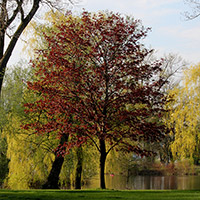Norway maple
Érable de Norvège
Acer platanoides L.Sapindaceae (soapberry family)Origin: Europe

Origin: Europe

Norway maple is a medium sized tree with a rounded symmetrical crown often as broad as the tree is tall.
Read more about Tree, Bark, TwigsThe leaves are palmately lobed with 5 to 7 often bristle-tipped lobes and a milky sap.
Read more about LeavesFlowers are small, greenish, borne in rounded clusters at the end of branches in spring.
Read more about FlowersFruits are pairs of winged seeds (samaras, also called keys) borne in clusters at the tips of branches.
Read more about FruitNorway maple is a fast-growing medium sized tree, up to 18 - 21 m (60' - 70') in height and up to 60 cm (24") in diameter.
Leaves are palmately lobed, wider than long, about 8 - 16 cm (3" - 6") long and 10 - 18 cm (4" - 7") wide. Each leaf has 5 to 7 lobes that often have bristle-tipped teeth.
Unlike sugar maple, Norway maple has milky white sap that can be seen when the leaf stalk is broken.
Fruits are pairs of winged seeds (samaras, also called keys) borne in clusters at the tips of branches. Green when young, they mature to brown.
Each key is about 3 - 5 cm (1" - 2") long. When mature, the two keys almost make an angle of 180 degrees.
Distribution
Native to Europe, Norway maple was introduced to North America around 1756 by the botanist and nurseryman John Bartram, who was central to the exchange of plant specie between Europe and North America. By the 1800s, Norway maple was a popular ornamental tree in North America. Tolerant of pollution and drought, by the mid 20th century it was the most frequently planted in towns and cities. Now Norway maple has been designated an invasive species because it has encroached on natural forests where its dense shade prevents young sugar maples from growing.
Derivation of names
The genus name Acer means sharp, referring to the sharp tips of the leaf lobes of most maples. The species name platanoides means resembling a plane tree (Platanus spp), from Platanus, the classical name for plane tree and oides, meaning resembling. See London plane-tree page for comparison of leaf shape.

Cultivars
There are many cultivars of Norway maple, including the popular Crimson King, which has maroon-coloured leaves.
Similar species
Norway maple is regularly confused with the native sugar maple (Acer saccharum). Sugar maple leaves never have 7 lobes; the sap is clear, visible when the leaf stalk is broken; the dangling flowers have no petals; and the pairs of samara wings (keys) are nearly paralell. Especially in winter, the two species can be distinguished by the bark. Sugar maple bark has vertical ridges that curl on one side while Norway maple bark has shallow, intersecting ridges in a regular, often diamond-shaped pattern.
Norway maple's place in Toronto's urban forest
Norway maple is the dominant tree of urban forests in many North American cities, including Toronto. Due to its tolerance of urban pollution, salt and other stresses it was planted by choice to replace elms destreoyed by Dutch Elm Disease in the mid 20th century. Today it is not only the most common planted tree in Toronto parks, yards and streets, but it has also independently invaded Toronto's remaining natural ecosystems.
Landscape value and potential for home planting
Because it threatens native species and ecosystems, it is widely recommended that Norway Maple not be planted. Further, because it has shallow roots and casts a dense shade, other plants, including grass will not grow beneath it, leaving bare ground.Pests and diseases: Norway maples are susceptible to Verticillum wilt, which can cause sudden wilting of the leaves. The wilting may be localized on one or two branches, but it may affect the entire canopy. It is not always fatal, but causes aesthetic problems. Especially obvious in wet summers, Norway maple is susceptible to infection by a fungus called tar spot Rhytisma acerinum which is ugly but not usually damaging to the tree.
Find trees on Tree Tour maps at Canadian Tree Tours: